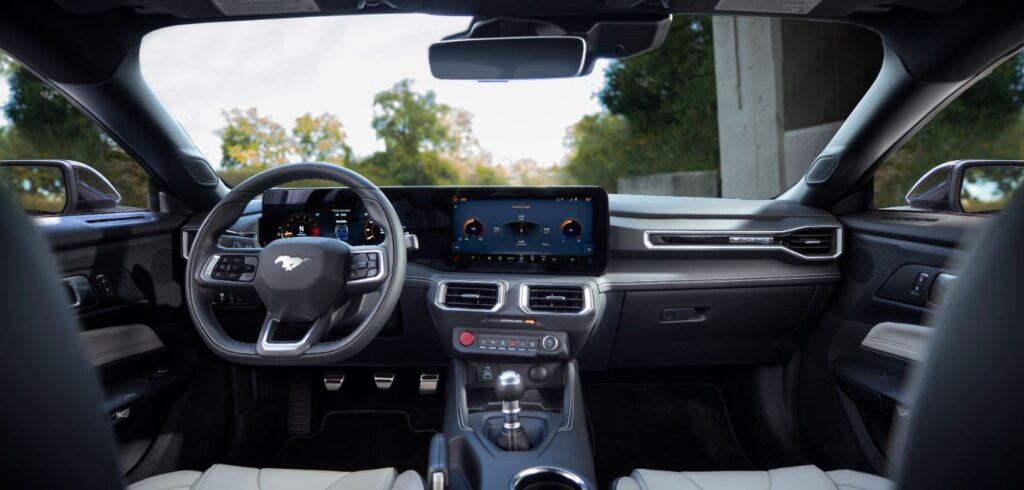For the new Mustang interior, Ford has stripped back the previous generation’s double-brow upper dashboard and installed a glass-clad open center stack, to create the OEM’s most advanced and driver-centric cockpit to date.
Behind the driver’s flat-bottom steering wheel is a 12.4in digital instrument cluster which can be customized to show a range of vehicle details depending on the selected drive mode. When choosing a drive mode a visualization of the vehicle setup is visible on the center stack powered by the Unreal Engine 3D software. The Mustang’s settings can then be changed by swiping and interacting with the virtual model.
Adjacent to the driver’s instrument cluster sits a newly developed 13.2in SYNC 4 center stack. Ergonomically positioned to face the driver, the screen benefits from easily accessible controls and delivers information to interior occupants. The SYNC 4 system is compatible with Apple CarPlay and Android Auto, and enables integration with the FordPass app. Additionally, the system can be updated using Ford’s Power-Up wireless update technology.
The interior furnishings now feature a new interior grain pattern, leather seats and soft-touch plastics for the instrument panel and door cards. The steering wheel is also completely covered in leather, with higher trim models benefitting from a choice of different color stitching on the wheel, center console and seatbelts. Furthermore, USB ports have been placed behind the steering wheel to enable the installation of track camera devices without wires hanging around in the cabin.
Sound is delivered through a 12-speaker Bang & Olufsen system complete with an additional subwoofer, and ambient interior lighting can also be configured to an individual’s requirements.
 “We’re taking advantage of every pixel,” said Craig Sandvig, interaction design manager, Ford Mustang. “We can be creative in showing necessary driving information and give the driver control of selecting colors, classic Mustang gauges or even a ‘calm’ screen where only minimal details are displayed.”
“We’re taking advantage of every pixel,” said Craig Sandvig, interaction design manager, Ford Mustang. “We can be creative in showing necessary driving information and give the driver control of selecting colors, classic Mustang gauges or even a ‘calm’ screen where only minimal details are displayed.”
“We knew what customers wanted and designed the most digital Mustang ever while retaining the all-important driver-focused cockpit,” added Ricardo Garcia, interior design manager, Ford. “Removing some of these physical buttons, such as radio and climate control, and integrating them into a digital display was popular in research with millennials, Gen-Z and traditional Mustang drivers alike.”




